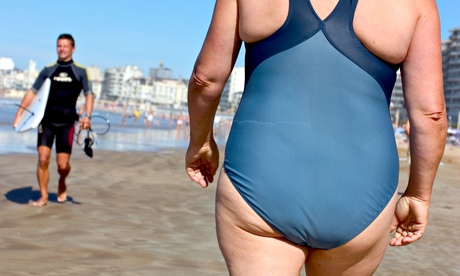
I spent much of my 20s being incredibly aware that my cellulite was considered disgusting by the magazines I read. When I discovered stretchmarks on my thighs aged 18, I cried in a changing room. I happily hoovered up lotions, creams, and depilatory products, all in the name of looking good and attaining this ideal of beauty I had so willingly absorbed. The distorted images of women that are fed to us constantly are unhealthy and damaging. But then, we know this, because it’s a subject that’s tackled on an almost daily basis. So surely it can only be a good thing when these ridiculous standards of beauty are challenged?
Recently, there has been a surge of blogs and pieces encouraging women to celebrate aspects of being a woman that previously wouldn’t have been seen as praiseworthy. This week I’ve read a few gushing pieces about the Hairy Legs club, which brightly welcomes you with the message: “This is a POSITIVE space.” This blog encourages women to throw away the razor and send in photos of their hairy legs (there’s the odd “fuck the patriachy” comment included for good measure).
If hairy legs don’t make you want to pop open the prosecco, then why not celebrate your cellulite, or show off your stretchmarks? There are also countless blogs which display photos of women after they have given birth, full of compliments, praise and exhortations that we should cherish our hard-won baby bellies.
But just as I used to hear a disapproving Greek chorus if I ate an ice-cream in the run up to “bikini body” season, I also feel a creeping sense of discomfort with this new celebratory movement. If you are happy to keep your body hair as nature intended, you’ve obviously made a choice that suits you well. But this new enthusiasm for documenting our bodies and cheerleading the personal decisions we make about them seems at best patronising, and at worst to be perpetuating the old, regimented way that women are required to see their bodies as comprised of positive or negative components.
We are naturally repulsed when we see various celebrity magazines employ the equivalent of the old circle of shame – scrutinising the bodies of female celebrities for “flaws” – but, instead of renouncing tactics like this, these blogs reinforce the message that women’s bodies should be constantly and closely examined, divided into constituent parts.
A site that shows women embracing their hairy legs unwittingly reinforces the notion that to be a hirsute woman is unattractive – it asks the reader to throw off the modern standard of femininity by creating a new one. To call stretchmarks “tiger stripes” is to imply that the marks themselves can only be borne if we learn to see them as something that we have earned. By celebrating our post-baby bodies, we admit that we view the parts that have changed as separate and specific physical entities which must pass some sort of muster.
This desire to rejoice in our form, whatever its shape, is yet another way for women to see our bodies as the priority. We may refuse to see our cellulite as ugly or unsightly, but we are still being asked to focus on an external part of ourself, to flip the negative into a positive and examine our physical attributes from a different angle. Is this what we see as progress? If you cannot imagine a blog where men happily praise each others’ beer guts then the answer must surely be no.
I have spent the past year running. I’ve got stronger and leaner. I can feel my physical strength increasing. I have learned to appreciate how each part of the body connects, and how wonderful it is to be able to use it fully. But this trend towards body positive language and imagery requires us to do the opposite; it asks us to see our bodies as superficial.
When writing about the history of the suffrage movement, Jeanette Winterson argued that if a woman cannot feel comfortable in her own body then she has no home. In order to feel fully at ease with ourselves, perhaps we should throw off the notion that one’s body, and one’s specific body parts, must be seen as either praiseworthy or wanting. Acceptance, rather than jubilation, is the only way we women might have a real chance of moving away from the constant fixation with our image.

